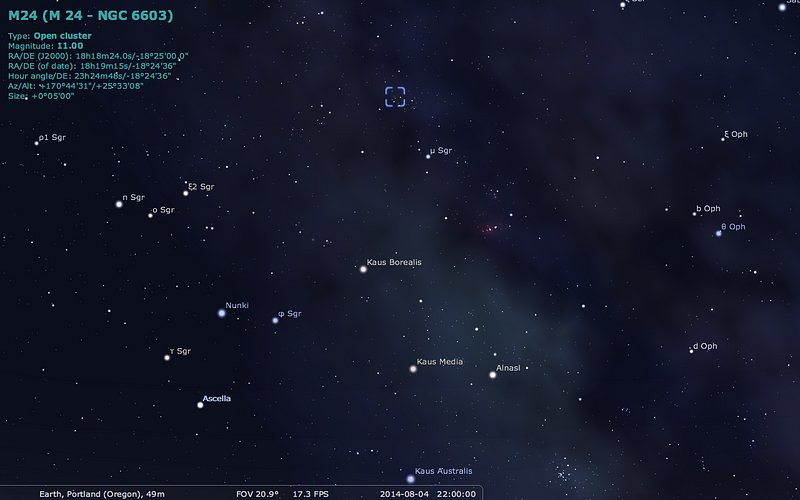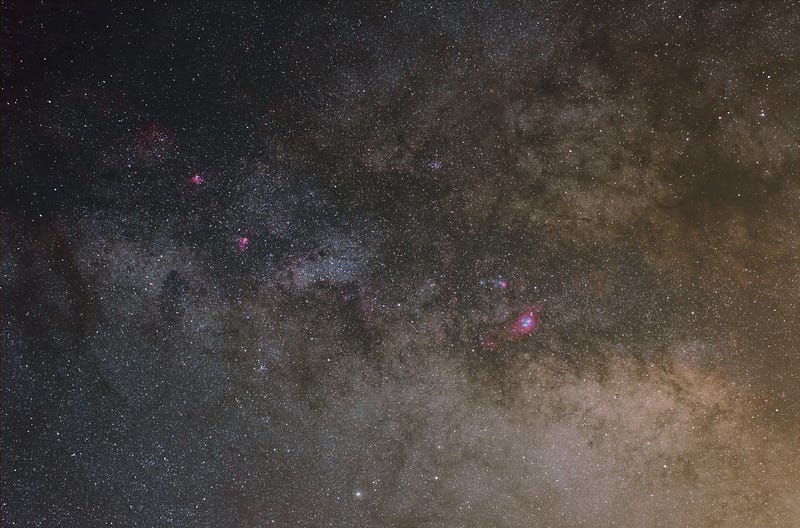Messier Monday: The Most Curious Object of All, M24
This star cloud is the only one of its kind: the densest large concentration of stars in the entire sky!
Image credit: Dan Bush of Missouri Skies, via http://www.pbase.com/image/115380497.
“It takes considerable knowledge just to realize the extent of your own ignorance.” –Thomas Sowell
Out of the 110 deep-sky objects in the Messier catalogue, 107 of them fall into five simple categories: stellar remnants, star-forming nebulae, open clusters, globular clusters and galaxies. Of the other three, two are true mistakes: the double star M40 and the quadruple star M73. But the one remaining anomaly — today’s object — is unlike anything else in the sky.

Located right in the plane of our galaxy — visible from the northern hemisphere most clearly after sunset on a summer’s night — lies the densest collection of stars the entire sky has to offer. But unlike the other stars that make up objects in the Messier catalogue, this isn’t a cluster we’re looking at, but a glimpse at one of our galaxy’s spiral arms, seen from our vantage point over 10,000 light-years away!
Today’s object is the one-of-a-kind curiosity: Messier 24, the Sagittarius Star Cloud. Here’s how to find it.

Once the skies darken after sundown tonight, the recognizable asterism of the teapot (in Sagittarius) should shine prominently above the horizon towards the south. If you look at the star that shines brightest directly “above” the top of the teapot — which you can also arrive at by extending the line between the two stars that connect the “spout” to the “pot,” Kaus Australis to Kaus Media — you’ll be well on your way to Messier 24.

Fainter than the brightest stars in the teapot but still prominent to the naked-eye, μ Sagittarii is actually a system of at least six stars located nearly 4,000 light years away, and if you follow the rough “arrow” created by it and its two nearby stars, 15 Sagittarii and 16 Sagittarii, a little farther north, you’ll come to an unmistakeable “cloud” of stars in the sky, richer in stars than any other comparably sized region as seen from Earth.

That hazy patch is itself Messier 24, and unlike most other Messier objects, is best viewed at low magnification or even through binoculars, because it’s absolutely huge on the sky, taking up the area-equivalent of about nine full Moons! Messier didn’t know what he was seeing but described it so:
“Cluster on the parallel of the preceding [M23] & near the end of the bow of Sagittarius, in the Milky Way: a large nebulosity in which there are many stars of different magnitudes: the light which is spread throughout this cluster is divided into several parts…”
Here’s a glimpse at what he was looking at.

This big, apparent cluster of brilliant white-and-blue in the sky really stands out from its surroundings. But the reason isn’t what you might have expected: you see, this isn’t a dense region containing more stars and matter than the surrounding ones.
Instead, this is a region of space that happens to have less light-blocking dust than the rest of the environs around it!

There are many other Messier objects around it, and those others are “true” objects: nebulae and star clusters, mostly. But this is a chance window, where there isn’t a substantial amount of light-blocking material located in this narrow region of sky, and we can see all the way through to the Sagittarius arm of the Milky Way, presently the closest spiral arm to the Sun!
If you were to take all the dust of the Milky Way away — or look in infrared wavelengths, where dust is invisible — this patch of sky would be representative of the entire galactic plane!

Instead, this is the one place in our sky that treats us to views this distant: the Sagittarius-arm seen through this gap-in-the-dust extends from about 10,000 to 16,000 light-years distant, and contains not only all sorts of different classes of stars, but also contains some nearby, foreground stars that appear to shine much more brightly than the vast majority of the ones in the distant arm.

Even on a night like tonight, where the Moon is bright and lingering in the sky, the Sagittarius star cloud is a spectacular feast for the eyes, whether your equipment is primitive (like a pair of department-store binoculars) or advanced. Although, with such a huge object, you’ll definitely want to enjoy the wide-field views it has to offer, and if you’re on a larger telescope, you very likely won’t be able to take it all in at once!

Some people mistakenly identify the small, faint cluster seen above towards the lower left — NGC 6603 — as Messier 24; it’s not, and don’t be fooled! Messier 24 is huge, and much larger than the individual cluster you see there. In fact, many interesting visual features, some of which are clusters and some of which are interstellar dust, abound in a wide-field view. Be sure and — if you have a high-powered telescope — take your time scrolling through the wonders of this region!

The best wide-field view, that really encapsulates just how spectacular this region is, comes via Deep Sky Astrophotography, and really shows off just how brilliant this portion of the sky is, particularly compared with everything else around it!

But if we want to see this up close, at say, professional resolution, we’d only be able to see a small portion of this region. Thankfully, the NOAO image I showed you earlier has that option available to it, in a whopping 15 Gigapixel image! Here’s just a slice — presented in optimal screen-resolution — for your viewing (and scrolling) pleasure.

And with that, we’ll come to the close of the most anomalous — but in many regards, the most spectacular — Messier Monday of them all! Including today, we’ve examined the following Messier objects:
- M1, The Crab Nebula: October 22, 2012
- M2, Messier’s First Globular Cluster: June 17, 2013
- M3, Messier’s First Original Discovery: February 17, 2014
- M4, A Cinco de Mayo Special: May 5, 2014
- M5, A Hyper-Smooth Globular Cluster: May 20, 2013
- M7, The Most Southerly Messier Object: July 8, 2013
- M8, The Lagoon Nebula: November 5, 2012
- M9, A Globular from the Galactic Center: July 7, 2014
- M10, A Perfect Ten on the Celestial Equator: May 12, 2014
- M11, The Wild Duck Cluster: September 9, 2013
- M12, The Top-Heavy Gumball Globular: August 26, 2013
- M13, The Great Globular Cluster in Hercules: December 31, 2012
- M14, The Overlooked Globular: June 9, 2014
- M15, An Ancient Globular Cluster: November 12, 2012
- M18, A Well-Hidden, Young Star Cluster: August 5, 2013
- M20, The Youngest Star-Forming Region, The Trifid Nebula: May 6, 2013
- M21, A Baby Open Cluster in the Galactic Plane: June 24, 2013
- M23, A Cluster That Stands Out From The Galaxy: July 14, 2014
- M24, The Most Curious Object of All: August 4, 2014
- M25, A Dusty Open Cluster for Everyone: April 8, 2013
- M27, The Dumbbell Nebula: June 23, 2014
- M29, A Young Open Cluster in the Summer Triangle: June 3, 2013
- M30, A Straggling Globular Cluster: November 26, 2012
- M31, Andromeda, the Object that Opened Up the Universe: September 2, 2013
- M32, The Smallest Messier Galaxy: November 4, 2013
- M33, The Triangulum Galaxy: February 25, 2013
- M34, A Bright, Close Delight of the Winter Skies: October 14, 2013
- M36, A High-Flying Cluster in the Winter Skies: November 18, 2013
- M37, A Rich Open Star Cluster: December 3, 2012
- M38, A Real-Life Pi-in-the-Sky Cluster: April 29, 2013
- M39, The Closest Messier Original: November 11, 2013
- M40, Messier’s Greatest Mistake: April 1, 2013
- M41, The Dog Star’s Secret Neighbor: January 7, 2013
- M42, The Great Orion Nebula: February 3, 2014
- M44, The Beehive Cluster / Praesepe: December 24, 2012
- M45, The Pleiades: October 29, 2012
- M46, The ‘Little Sister’ Cluster: December 23, 2013
- M47, A Big, Blue, Bright Baby Cluster: December 16, 2013
- M48, A Lost-and-Found Star Cluster: February 11, 2013
- M49, Virgo’s Brightest Galaxy: March 3, 2014
- M50, Brilliant Stars for a Winter’s Night: December 2, 2013
- M51, The Whirlpool Galaxy: April 15th, 2013
- M52, A Star Cluster on the Bubble: March 4, 2013
- M53, The Most Northern Galactic Globular: February 18, 2013
- M56, The Methuselah of Messier Objects: August 12, 2013
- M57, The Ring Nebula: July 1, 2013
- M58, The Farthest Messier Object (for now): April 7, 2014
- M59, An Elliptical Rotating Wrongly: April 28, 2014
- M60, The Gateway Galaxy to Virgo: February 4, 2013
- M61, A Star-Forming Spiral: April 14, 2014
- M63, The Sunflower Galaxy: January 6, 2014
- M64, The Black Eye Galaxy: February 24, 2014
- M65, The First Messier Supernova of 2013: March 25, 2013
- M66, The King of the Leo Triplet: January 27, 2014
- M67, Messier’s Oldest Open Cluster: January 14, 2013
- M68, The Wrong-Way Globular Cluster: March 17, 2014
- M71, A Very Unusual Globular Cluster: July 15, 2013
- M72, A Diffuse, Distant Globular at the End-of-the-Marathon: March 18, 2013
- M73, A Four-Star Controversy Resolved: October 21, 2013
- M74, The Phantom Galaxy at the Beginning-of-the-Marathon: March 11, 2013
- M75, The Most Concentrated Messier Globular: September 23, 2013
- M77, A Secretly Active Spiral Galaxy: October 7, 2013
- M78, A Reflection Nebula: December 10, 2012
- M79, A Cluster Beyond Our Galaxy: November 25, 2013
- M80, A Southern Sky Surprise: June 30, 2014
- M81, Bode’s Galaxy: November 19, 2012
- M82, The Cigar Galaxy: May 13, 2013
- M83, The Southern Pinwheel Galaxy, January 21, 2013
- M84, The Galaxy at the Head-of-the-Chain, May 26, 2014
- M85, The Most Northern Member of the Virgo Cluster, February 10, 2014
- M86, The Most Blueshifted Messier Object, June 10, 2013
- M87, The Biggest One of them All, March 31, 2014
- M88, A Perfectly Calm Spiral in a Gravitational Storm, March 24, 2014
- M89, The Most Perfect Elliptical, July 21, 2014
- M90, The Better-You-Look, The Better-It-Gets Galaxy, May 19, 2014
- M91, A Spectacular Solstice Spiral, June 16, 2014
- M92, The Second Greatest Globular in Hercules, April 22, 2013
- M93, Messier’s Last Original Open Cluster, January 13, 2014
- M94, A double-ringed mystery galaxy, August 19, 2013
- M95, A Barred Spiral Eye Gazing At Us, January 20, 2014
- M96, A Galactic Highlight to Ring in the New Year, December 30, 2013
- M97, The Owl Nebula, January 28, 2013
- M98, A Spiral Sliver Headed Our Way, March 10, 2014
- M99, The Great Pinwheel of Virgo, July 29, 2013
- M100, Virgo’s Final Galaxy, July 28, 2014
- M101, The Pinwheel Galaxy, October 28, 2013
- M102, A Great Galactic Controversy: December 17, 2012
- M103, The Last ‘Original’ Object: September 16, 2013
- M104, The Sombrero Galaxy: May 27, 2013
- M105, A Most Unusual Elliptical: April 21, 2014
- M106, A Spiral with an Active Black Hole: December 9, 2013
- M107, The Globular that Almost Didn’t Make it: June 2, 2014
- M108, A Galactic Sliver in the Big Dipper: July 22, 2013
- M109, The Farthest Messier Spiral: September 30, 2013
Come back tomorrow, where we’ll have more wonders of the Universe on tap, and next Monday for another exciting Messier object that you can find even with a full Moon shining, only here on Starts With A Bang!
Leave your comments at the Starts With A Bang forum on Scienceblogs!





